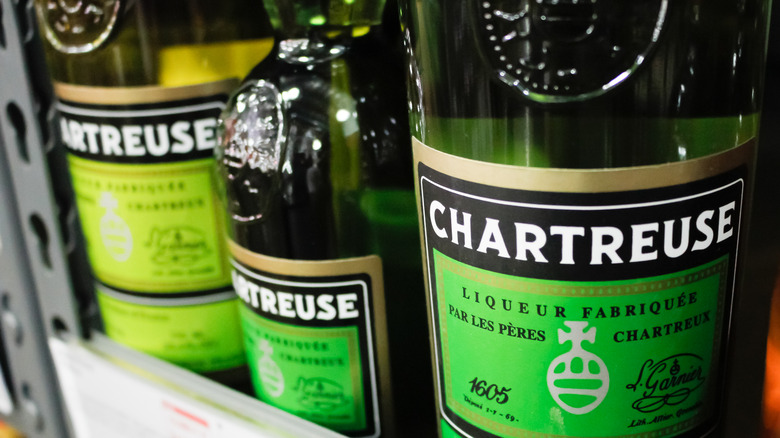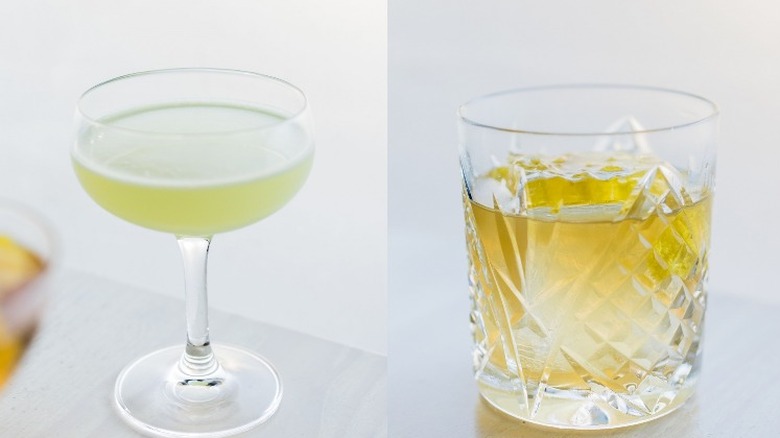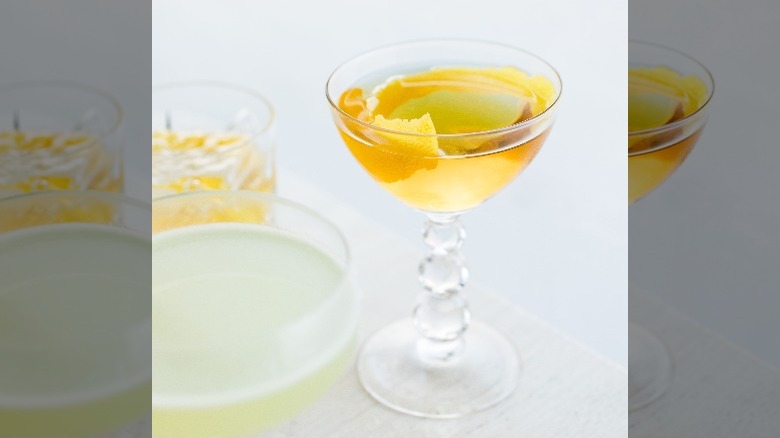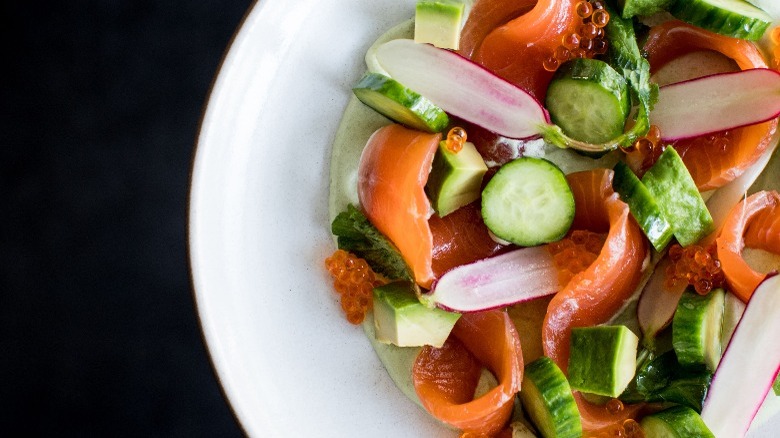Everything You Didn't Know About Chartreuse
Chartreuse is a liqueur produced by a group of monks called the Order of the Carthusians, first established in 1084. Their intention was to return to the solitary, austere lives of early Christian hermits, according to English Heritage. Settling in the Chartreuse Mountains outside of Grenoble, France, the Order is made up of both monks and nuns, who live their lives in prayerful contemplation, separate from the outside world.
Over time, the monks began developing plants and herbs for medicinal purposes (via Chartreuse). In 1605, the French Marshall d'Estrées, knowing the Order's extensive knowledge of herbology, gifted them with the "Elixir Végétal." The brand explains that this was a centuries-old document of unknown origin thought to contain the recipe for the "Elixir of Long Life." Chartreuse speculates it was created by a 16th-century alchemist with advanced knowledge of herbology, but the recipe was so complex the monks were only able to decipher and use parts of it.
The Order spent many years perfecting the recipe, producing the Elixir in 1764, followed by the first bottles of Green Chartreuse in 1840. Since the elixir recipe was gifted in 1605, people have pared the date down to 16/05 or May 16 — what is now known as Chartreuse Day.
The exact ingredients of the herbal liqueur are a well-guarded secret
Chartreuse is made up of a mix of 130 different plants and herbs, but the exact recipe is a secret known only to two monks and the father of the order, The Washington Post reports. Even the exact amount of time the liqueur needs to age is known only to them, as well as what specific ingredients give it its bright green and yellow colors. The distinctive lime green color of Chartreuse is actually the only known liqueur with a completely natural green hue.
To guard the recipe, herbs are delivered in numbered, nondescript bags so even the employees at the distillery won't be able to guess the ingredients. These custom bags are delivered directly to the monastery, each containing the unique 130-herb blend. Distillery Worker Bertrand de Neve told France 24, "We don't know anything about the recipe. We work like a cook who doesn't know the basis of the recipe. Everything's left to the imagination and it's best that way."
All of the profits from liquor sales go to support the Carthusians, according to BBC News. As of 2015, they saw annual sales of over 1.5 million bottles at an average of $50 a bottle. It's "a blessing for the monastery's coffers," France 24 notes.
The green and yellow Chartreuse have different flavor profiles
Green Chartreuse has the expected herbal, earthy flavors, but because it's aged in oak barrels, it ends up with a slight woodiness as well. There's a soft bitterness on the palate, which some tasters can find harsh, but it's balanced by a light sweetness. While no one knows what the actual herb mixture is, people have tried to guess based on what they're tasting, and front runners tend toward star anise, rosemary, mint, pepper, and sage. No one note is prevalent, though some even suggest tasting chocolate or vanilla as well, which, Wine Dharma notes, could be brought out from the wood aging.
While both green and yellow Chartreuse are made with similar herbs, the yellow Chartreuse has a slightly sweeter flavor. The yellow Chartreuse has a slightly mellower character as well, primarily due to the lower alcohol content — the yellow is 80 proof/43% ABV versus the green at 110 proof/55% ABV, per the brand. While the herbal profile is very similar, the lower alcohol makes it smoother and less harsh on the palate, with notes of honey and citrus coming more forward among the herbal blend.
The herbal flavor of Chartreuse makes it a great cocktail mixer
One of the most popular of Chartreuse cocktails is a Last Word, a drink that was developed at the Detroit Athletic Club in 1915, per Liquor.com. Equal parts gin, green Chartreuse, maraschino liqueur, and lime juice, the drink is garnished with a brandied cherry. It's sweet, tart, and herbaceous, a perfectly balanced drink.
Few people are more passionate about Chartreuse than Paul Einbund, owner of The Morris in San Francisco's Mission district (a 2020 James Beard semifinalist for outstanding wine program). His enthusiasm for the liqueur shows in everything from a Chartreuse tattoo on his inner forearm to an impressive breadth of knowledge of Chartreuse mixology. He told Mashed, "One of my favorite Chartreuse cocktails is the Widow's Kiss. The most standard version of this drink was created in 1895 and is made with 1 oz apple brandy or calvados, 1/2 oz Benedictine liqueur — to make it extra monk-y — and 1/2 oz yellow Chartreuse with a couple of dashes of Angostura bitters. Plus the digestive qualities of Chartreuse are great after a big meal!"
Because the yellow and green have slightly different flavor profiles, the two are not always interchangeable and are usually used for different mixology recipes.
You can cook with Chartreuse too
The Morris' Executive Chef Gavin Schmidt is a fan of Chartreuse as well, and does a specialty menu every year for International Chartreuse Day, showcasing the spirit in every course. "I love cooking with Chartreuse because it's so versatile," he told Mashed. "For example, I can macerate some strawberries in yellow Chartreuse to make a delicious, soft, herbaceous syrup, then deglaze morel mushrooms in it. The soft sweet, anise-y flavors are an amazing counterbalance to the mushrooms' earthiness. I've also marinated cucumbers in green Chartreuse for an exciting bright punch to a cucumber and goat cheese salad. And the list goes on." For this year's celebration, he is serving rabbit terrine with Chartreuse, apricot, and pistachio, as well as an Alpine gravlax with avocado, radish, and Chartreuse-marinated cucumber.
Chef and author David Lebovitz agrees. As he states on his personal website, "Chartreuse has a sharp herbal flavor that I find pairs particularly well with dark chocolate." He uses it in a Chartreuse soufflé with chocolate sauce, where the liqueur adds a hint of aromatics.
Fine Cooking also recommends using Chartreuse in sauces or butter, where it adds a floral note.




